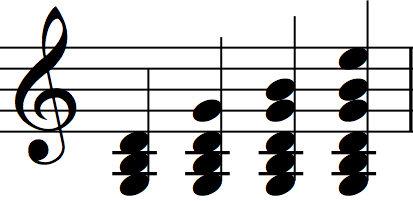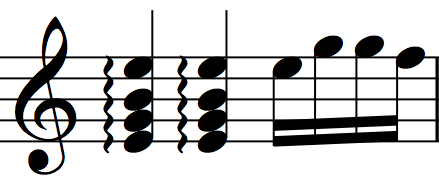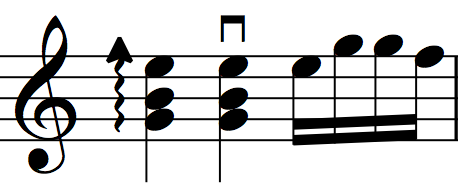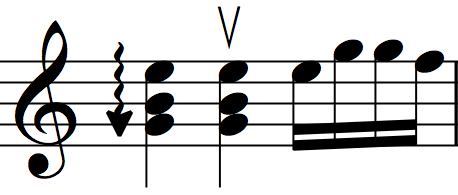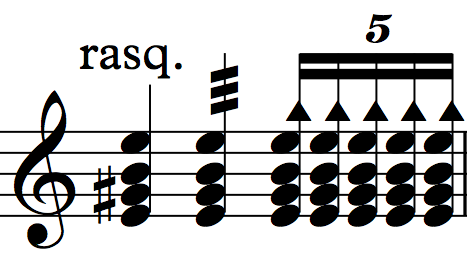20 Intervals, Chords & Strums
INTRODUCTION
In this unit you will learn intervals, chords and strumming notations.
NOTATIONS
Harmony
A harmony is two or more noted that sound simultaneously. Below are two types of harmonies played on the guitar: the interval and the chord.
Interval
The interval consists of two vertically stacked notes. The stacking indicates that the notes are to be played simultaneously, or nearly simultaneously.
Chord
The chord consists of three or more vertically stacked notes. The stacking indicates that the notes are to be played simultaneously, or nearly simultaneously.
Strum Types
Strum
The strum consists of a wavy line that directly precedes an interval or a chord.
Down Strum
The down strum consists of a wavy line with an arrow pointing to the top of the score that precedes an interval or chord. The arrow direction indicates that the strum should start with the low pitches and proceed to the high pitches. Alternatively, an arrow pointing to the top of the score can be placed directly above the interval or chord meant to be strummed.
Up Strum
The up strum consists of a wavy line with an arrow pointing to the bottom of the score that precedes an interval or chord. The arrow direction indicates that the strum should start with the high pitches and proceed to the low pitches. Alternatively, an arrow pointing to the bottom of the score can be placed directly above the interval or chord meant to be strummed.
Rasgueado
The rasgueado is associated with flamenco guitar technique but is actually used in many genres. It is commonly notated in the following ways: with the abbreviation rasg., with the tremolo symbol or as a set of sixteenth notes in combination with up and down strum symbols.
Let’s Play |
Sight-Reading Tip
We open ourselves to judgement from others (and ourselves) when we play and perform music. These situations can build up character or take it down. On one hand, performing artists can develop resilience and healthy responses to criticism. On the other hand, performing artists can allow their creativity to be undermined by accepting judgement from people who can’t give informed and constructive criticism. Accepting criticism from the wrong source is like going to a Pakistani restaurant expecting to eat Mexican food. When hungry for feedback, consider the following before allowing another person’s judgement to have an effect on your artistic life. Is the person:
- capable of clearly observing the subject and event in question?
- qualified to comment on the particular subject in question?
- unshackled from a bias toward you or the subject in question?
- capable of giving critical yet constructive feedback?
- applying the advice given to you in his or her own life?
Checklist for Sight-Reading
- Count the beats out loud (including the &).
- Keep going (even if you make a mistake).
- Maintain your best playing posture.
- Look at the score, not your hands.
- Play with the feel of the meter.
- Play patterns instead of individual notes (AKA chunk).
- Cultivate a calm demeanor.
- Have fun!
Let’s Play Rhythms |
Attitude Tip
The true method is not methodical. If you tire of continual creative exploration, and yearn for certainty, tune your guitar. –Peter Yates
Exercise 20.1: Score
Exercise 20.1: Audio
Exercise 20.2: Score
Exercise 20.2: Audio
Exercise 20.3: Score
Exercise 20.3: Audio
Exercise 20.4: Score
Exercise 20.4: Audio
Let’s Play Patterns |
Attitude Tip
Patience is to be respected until it fails to produce, at which point impatience should demand a new approach. Interplay between these opposites allows progress to occur. –Peter Yates
Exercise 20.5: Score
Exercise 20.5: Audio
Exercise 20.6: Score
Exercise 20.6: Audio
Exercise 20.7: Score
Exercise 20.7: Audio
Exercise 20.8: Score
Exercise 20.8: Audio
Let’s Play Duets |
Attitude Tip
The savvy player will learn to anticipate passages that require careful attention to the hands. The rest of the time, she just plays the varied sounds that need to be heard. Life is short. –Peter Yates
Double by Jean-Philippe Rameau: Score
Double: Audio
Cradle Song by Wilhelm Friedrich Ernst Bach: Score
Cradle Song: Audio
Pholoé is transcribed for voice and two guitars. The play-along track contains only the Guitar 2 part. However, the vocal part is included in the score in case you aspire to perform this exquisite song with a singer and another guitarist!
Pholoé from Étude Latines by Reynaldo Hahn: Score
Pholoé from Étude Latines : Audio
Let’s Play Compositions |
These compositions are under the Creative Commons Attribution-NonCommercial 4.0 International License (CC BY-NC 4.0).
Attitude Tip
By confronting music never before heard, wondering every day how it should go and whether it has merit, one takes on a flexible authority which is recognizable in the playing, and which cannot be achieved by playing only the certified, recorded and over-performed repertoire. –Peter Yates
Intervals by Emile Porée: Score
Intervals: Audio
Love Skunk by Peter Yates: Score
Love Skunk: Audio
Macaria is in 4/2 meter. Each measure contains four beats. Each beat is represented by a half note. Since there are four half note beats per measure, the count-in bell will be struck four times.
Macaria by Paweł Kuźma: Score
Macaria: Audio
The Guitar 1 part of Efykay contains two voices, which makes sight-reading difficult. If you would like to simplify the sight-reading process, I suggest you sight-read Guitar 1’s top voice only, then Guitar 1’s bottom voice only, and finally, attempt to play both voices at the same time.
Efykay by Felix Salazar: Score
Efykay: Audio
Congratulations!
You have completed this unit! If you kept up with the beat and accurately played approximately 70% of the pitches and rhythms, you are ready for the next unit. Feel free to repeat the exercises. However, do not play them so often that you memorize them. Once you memorize the notation, you are no longer developing the skill of sight-reading.


